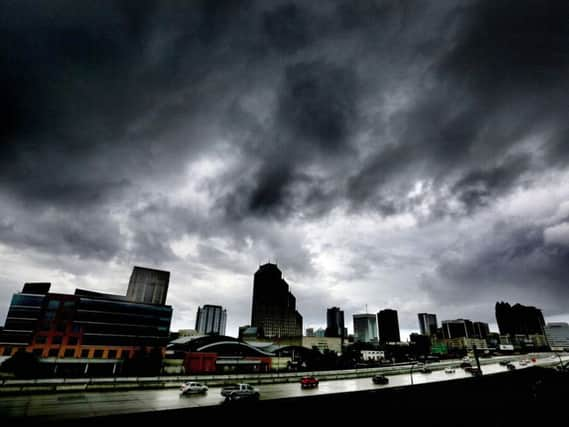Hurricane Matthew pelts Florida as East Coast prepares for battering


It was the most powerful storm to threaten the US Atlantic coast in more than a decade, and had already left more than 280 dead in its wake across the Caribbean.
"This storm's a monster," Florida governor Rick Scott warned as it started lashing the state with periodic heavy rain and squalls at around nightfall on Thursday. He added: "I'm going to pray for everybody's safety."
Advertisement
Hide AdAdvertisement
Hide AdAs it moved north in the evening, Matthew stayed about 100 miles or more off South Florida, sparing the 4.4 million people in the Miami and Fort Lauderdale areas from its most punishing effects.
But by night-time, more than 80,000 homes and businesses were without power. Streets in Vero Beach were partially covered with water, and hotel guests in Orlando were told to stay inside, though a few sneaked out to smoke or watch the rain.
The hurricane was expected to blow ashore - or come dangerously close to doing so - north of Palm Beach County, which has about 1.4 million people, and then slowly push north for the next 12 hours along the Interstate 95 corridor, through Cape Canaveral and Jacksonville, according to the National Hurricane Centre.
Forecasters said it would then probably hug the coast of Georgia and South Carolina over the weekend before veering out to sea - perhaps even looping back towards Florida in the middle of next week as a tropical storm.
Advertisement
Hide AdAdvertisement
Hide AdMillions of people in Florida, Georgia and South Carolina were told to evacuate their homes, and highways were turned into one-way routes to speed the exodus. Florida alone accounted for about 1.5 million of those told to clear out.
"The storm has already killed people. We should expect the same impact in Florida," the governor warned.
Many boarded up their homes and businesses and left them to the mercy of the storm.
"We're not going to take any chances on this one," said Daniel Myras, who struggled to find enough plywood to protect his restaurant, the Cruisin Cafe, two streets from the Daytona Beach boardwalk.
Advertisement
Hide AdAdvertisement
Hide Ad"A lot of people here, they laugh, and say they've been through storms before and they're not worried. But I think this is the one that's going to give us a wake-up call."
The hurricane picked up wind speed as it closed in, growing from a possibly devastating Category 3 storm to a potentially catastrophic Category 4. Forecasters said it could dump up to 15 inches of rain in some spots and cause a storm surge of nine feet or more.
They said the major threat to the Southeast would not be the winds, which newer buildings can withstand, but the massive surge of sea water that could wash over coastal communities along a 500-mile stretch from South Florida to the Charleston, South Carolina, area.
President Barack Obama declared a state of emergency for Florida, Georgia and South Carolina, freeing up federal money and staff to protect lives and property.
Advertisement
Hide AdAdvertisement
Hide AdFort Lauderdale's airport shut down and the Orlando airport planned to do so as well. Palm Beach International Airport reported a wind gust of 50mph with the centre of the storm 70 miles offshore, the National Hurricane Centre said. Airlines cancelled more than 3,000 flights on Thursday and Friday, many of them in or out of Miami and Fort Lauderdale.
Amtrak suspended train service between Miami and New York, and cruise lines rerouted ships to avoid the storm, which in some cases will mean more days at sea.
Orlando's world-famous theme parks, Walt Disney World, Universal Studios and SeaWorld were closed.
Thousands of people fled to schools converted to shelters, and inland hotels in places such as Charlotte, North Carolina, reported brisk business.
Advertisement
Hide AdAdvertisement
Hide AdAt the Kennedy Space Centre in Cape Canaveral, Nasa no longer has to worry about rolling space shuttles back from the launch pad to the hangar because of hurricanes, since the shuttle fleet is now retired. But spaceflight company SpaceX was concerned about the storm's effect on its leased seaside pad.
As evening fell, the winds picked up along Vero Beach, mid-way between West Palm Beach and Cape Canaveral, stripping away palm fronds, ripping awnings and blowing sand that stung the face. Waves crashed on the beach, and rain came in short bursts.
The last Category 3 storm or higher to hit the US was Wilma in October 2005. It sliced across Florida with 120 mph winds, killing five people and causing an estimated 21 billion dollars in damage.
Meanwhile Haiti's Interior Ministry said the confirmed death toll the hardest-hit south-western zone was 283 and it is expected to rise as authorities reach remote places left isolated by the storm.
Advertisement
Hide AdAdvertisement
Hide AdBodies have started to appear as waters recede in some areas two days after Matthew smashed concrete walls, flattened palm trees and tore roofs off homes.
In the Bahamas, authorities reported many downed trees and power lines but no immediate deaths.